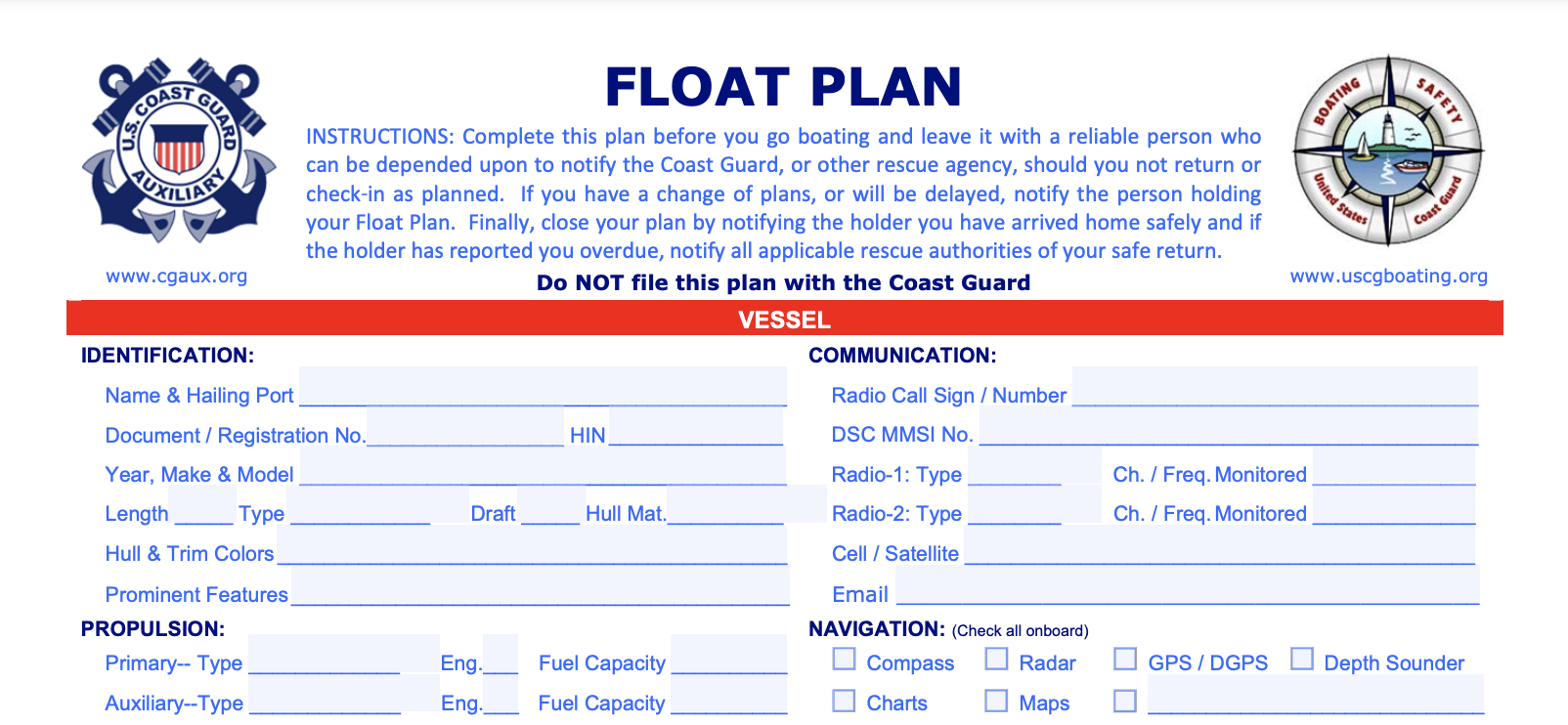The USCG Float Plan is a state-of-the-art lifesaving resource. It is used by search and rescue personnel to locate you in the shortest amount of time possible. It also guides and directs the float plan holder on what to do during a boating emergency.
Click here to download the USCG Float Plan.
Here is everything you need to know about the Float Plan Form published by the USCG.
What is a float plan?
A float plan is a document that outlines your expected journey on the water. It typically includes a description of your vessel, who will be on board, a description of the safety equipment carried, where you are going, and when you expect to get there.
Who should prepare a float plan?
Everyone. Including jet skiers, fishermen, waterskiers, day cruisers, sailors, powerboaters, and even kayakers, canoeists, and stand-up paddlers. The USCG Float Plan is equally effective for owners of big and small boats.
All persons onboard should be aware of its contents and importance. Generally, the vessel operator is the one that prepares the float plan. If you are a passenger, do not be afraid to ask the operator if they have a float plan.
What is a float plan holder?
After completing a float plan, you will need to make arrangements with someone you trust to hold the plan and be mindful of your trip. This person is known as the "holder." They will track the planned check-in and return times on your itinerary and follow up if unnecessary. If you don't show up when expected, it will be nice to have someone raise an alert to look out for you.
Choose a primary method of communication that will work best for the two of you. It could be text messages, phone calls, emails, etc. Instruct the person holding the float plan to notify the Coast Guard or other rescue services if you do not return within a reasonable time of your scheduled arrival. After you arrive at your destination, or if your plans change, inform the holder to avoid unnecessary worry or search and rescue efforts.
How do I file a float plan?
There are numerous templates available online, but SkiSafe recommends the official float plan of the U.S. Coast Guard. Do not file it with the Coast Guard. They do not accept float plans. Instead, print or share it electronically with various people/entities.
If you are cruising for just a few hours, let your holder know where you expect to be and when to return. For longer voyages, consider leaving a copy of the written float plan with your marina, insurance company, trusted relatives, or friends, etc. Many insurance companies require customers to complete one to satisfy underwriting needs when reviewing a plan for an extended cruise.
What information is included in a float plan?
A comprehensive float plan should include the following information:
Vessel Identification Details
- Boat Name
- Registration Number
- Year, Make & Model
- Boat Size
- Hull & Trim Color
- Type of Engine
- Unique Features (flag, wakeboard tower, etc.)
» MORE: USCG Requirements for Recreational Vessels
Vessel Communication and Navigation Details
- Radio Call Sign/Number
- DSC MMSI No.
- Radio-1 Type
- Radio-2 Type
- Channels/Frequency Monitored
- Cell/Satellite
- Email address
- Navigation Equipment Onboard (compass, charts, radar, maps, depth sounder, GPS/DGPS, EPIRB)
Safety Equipment Onboard
- Sound Signals (bell, horn, whistle)
- Visual Distress Signals (electric distress light, flag, flare, signal mirror, smoke)
- Anchor & Line Length
- Dewatering Device
- Exposure Shifts
- Fire Extinguisher
- Flashlight/Searchlight
- Raft/Dinghy
- Food/Water
- Number/Color of Life Jackets
» MORE: Recreational Boating Activity Safety Guide
Passenger Information
- Boat operator's name, address, and telephone number
- Number of passengers on board and their names, addresses, and telephone numbers
- Emergency contact information for all aboard
Trip Itinerary
- Day/time of trip departure(s)
- Day/time of trip arrival(s)
- Location/waypoint
- Mode of travel
- Reason for stop
- Check-in times
USCG Float Plan - Boating Emergency Guide
The third and final page of the USCG Float Plan includes the Boating Emergency Guide. The guide assists the person holding your plan to initiate the search and rescue process.
In emergencies, holders are advised to contact local rescue authorities that respond to marine crises (e.g., police, sheriff, constable, first responder, etc.) and ask the dispatcher to respond to a late return or check-in by the persons on board.
Holders will also provide information for rescue teams, such as the voyage's purpose, how long the vessel has been overdue, the vessel's departure point, destination, and more.

